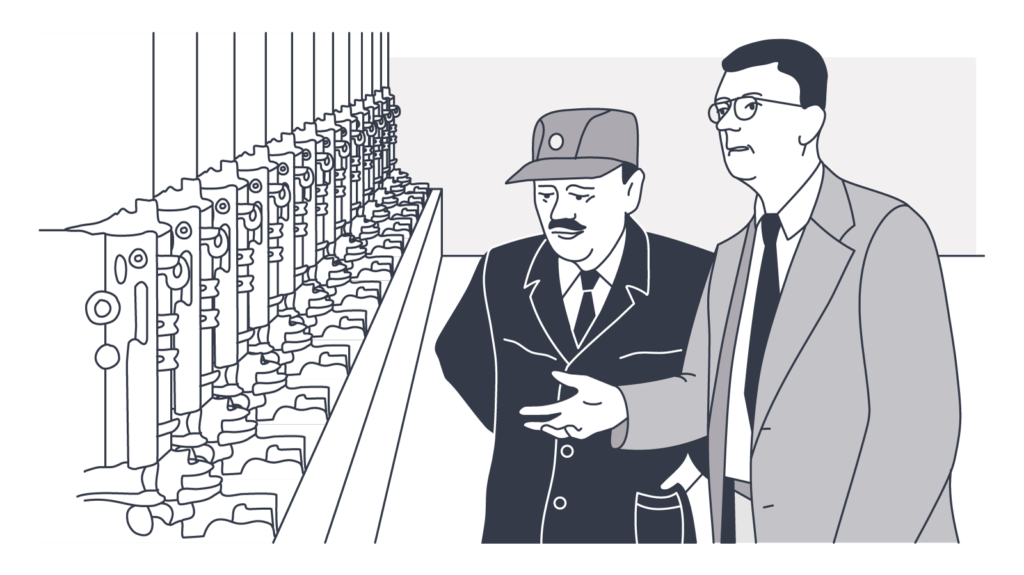Edward Deming’s Radical Theory

This is Part 1 of a 3 part series. In this series, we tell the story of two men: Edward Deming and Dr. Brent James. Their understanding of systems improvement, and focusing on quality from the outset, has radically shifted the level of care being delivered in hospitals and medical centres all over the world. In one hospital chain, Intermountain Healthcare, mortality rates were reduced by 2,000 per year, while costs were slashed by hundreds of millions of dollars. All through focusing on quality first and foremost. But before we get to that, let’s start at the beginning.
In the 1920s you could go into a store anywhere in the world and the shopkeeper was likely to reach under the counter and pull out an American product. US goods were known the world around as high quality and 50% of all goods mass produced came from US manufacturers.
After World War II, this began to change. US manufacturers had gotten lazy. They didn’t believe it was important to pay much attention to what customers wanted to buy. Nor did they think quality was something consumers would be willing to pay for. They also thought the notion that Japan — a country known for shoddy merchandise — could ever present the US with serious competition was ludicrous.
This was the reaction Edward Deming received when he first started telling US executives that by improving quality they could both sell more and reduce costs.
Meet Edward Deming
Edward Deming, who was born in 1900, obtained a bachelor’s degree in electrical engineering and a PhD in statistics from Yale.
When he first saw the problem with the direction US manufacturing was going, he approached executives to warn them. His message was simple, yet profound – he told executives that by improving quality, they could reduce their expenses, increase productivity, and ultimately, control more of the market.
Deming felt that rather than inspecting products for defects after they were made, the manufacturing process should be redesigned to make sure high-quality products were built right from the start. His message fell on deaf ears.
Japan is ready for Deming’s message
After World War II, Japan’s economy was struggling. So much so, that General Douglas MacArthur, frustrated at his inability to complete a phone call in Japan without the line going dead, requested that Deming be brought to Japan.
Because of his expertise in quality control techniques, once in Japan, Deming was invited to speak in front of the Japanese Union of Scientists and Engineers. As it turned out, the war had left the Japanese more than willing to listen to what Deming had to say.
In particular, Japanese businessmen were already aware that the goods they were manufacturing were shoddy in comparison to what their overseas competitors were producing. Likewise, they couldn’t afford to waste raw materials producing things that didn’t meet post-production inspection standards.
So, in 1950, Deming began training hundreds of Japanese engineers, managers and scholars. He even had the distinction of training top industrialist, Akio Morita, Sony’s Co-Founder, and Kiichiro Toyoda, Toyota Founder.
Deming taught the Japanese manufacturers that focusing on improving the quality of their goods from the very beginning would actually reduce costs because it would cut back on recalling products and rectifying damages later down the track.
He explained that this focus on quality would also improve market share because customer loyalty and word of mouth would improve.
In essence, Deming’s approach involved documenting every possible process in a company, pinpointing those processes that had the biggest impact on a business’ bottom line, and improving those processes first.
As Japanese manufacturers began implementing Deming’s techniques, their productivity skyrocketed, as did the quality of their goods. These factors – coupled with the lower cost of Japanese products – created new international demand for Japanese goods.
Sony and Toyota were among the first two companies to become world-class producers after adopting Demings’ teachings.
Ford gets it… finally
After some time, American executives began to notice that some Japanese products were superior to their American counterparts. For instance, Ford Motor Company began manufacturing a car in the 50s with two models – one with an American transmission and one with a Japanese transmission.
When Ford customers began requesting the car with the Japanese transmission and were even willing to wait for it, Ford engineers wanted to understand why, since the transmissions were made to the same specifications.
So, they took both transmissions apart and discovered that the parts used in the Japanese transmission showed much less variation. In the Japanese motors each part was within 1/16th of the specifications, while the US parts were within 1/8th. This made the cars with Japanese transmissions run much smoother, with less problems.
Despite this realisation, it still took Ford several decades, before it was willing to get on board with Deming’s quality movement.
That moment came in the early 1980s. Ford was hemorrhaging money, incurring $3 billion in losses between 1979 and 1982. Ironically, in 1980, the company had undergone the largest recall in American history for defective transmissions. In an effort to turn things around, Larry Moore, Ford’s newly appointed Corporate Quality Director, recruited Deming to start a quality movement at Ford.
When Deming came on board, he told Moore that management’s actions were responsible for 85% of all of Ford’s problems in developing better cars. That’s because after arriving at Ford, Deming felt that the company had the most incompetent upper management he’d ever encountered, with executives acting like warring gang lords, viewing any change as a threat to their organisational power.
Even so, Deming’s consulting work did manage to turn things around. In 1986, Ford introduced the profitable Taurus-Sable line.
Ford chairman, Donald Petersen, wrote at the time, ‘We are moving toward a quality culture at Ford and the many changes that have been taking place here have their roots directly in Deming’s teachings.’
That same year, Ford became the most profitable American automobile company. For the first time in over 40 years, Ford was earning more than General Motors. In the following years, the company’s earnings continued to surpass General Motors and Chryslers.
The big lesson from all of these companies is simple yet deeply profound: focus solely on quality and everything else will improve. This is a lesson that has even stood true in healthcare.
When Deming’s methods were used by Dr. Brent James at Intermountain Healthcare, the hospital chain’s mortality rates dropped by thousands per year, while operation costs were reduced by hundreds of millions of dollars in just a few short years.
Dr. James is heralded as one of the most iconic men in the history of qualitative systems improvement. Even the New York Times can’t write a feature article on him that’s less than 8,000 words.
Read the full story of how Dr. James leveraged Deming’s principles at Intermountain Healthcare’s hospitals in Part 2: Dr. Brent James – The Man Who Saved 2,000 Lives a Year, While Reducing Hospital Costs By Hundreds of Millions of Dollars.



